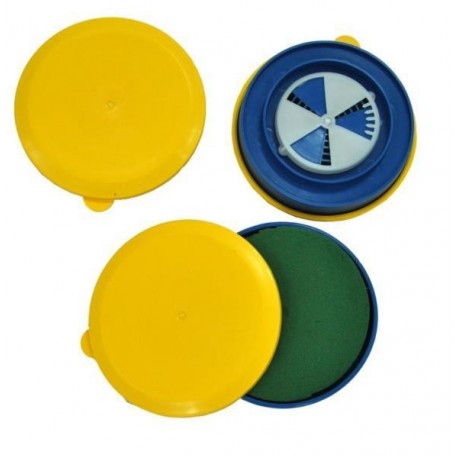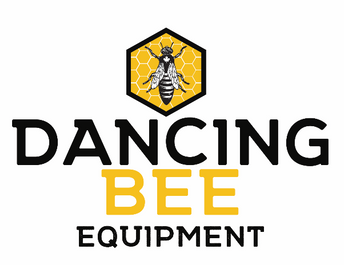
Lyson | Dispenser for Formic or Acetic Acid
Formic and acetic acid dispenser – a simple and helpful solution for your apiary
With the arrival of September, it is time to finally deal with the population of the Varroa destructor, which weakens the winter bee generation. It is also worth protecting the combs taken out from the hives against the destructive effect of the Wax moth. In both cases, a 120 ml acid dispenser from the Łyson company offer may prove helpful.
Formic acid – an effective way to combat Varroa
Most pharmaceuticals are expensive, so beekeepers are increasingly looking to find other solutions. Some of those are very effective and at the same time inexpensive to use. Formic acid has been known for years and proven in apiaries. It is an organic chemical compound, namely carboxylic acid. The biggest advantage of its application is that it fights Varroa destructor not only on bees themselves – like other medications – but also those hidden inside the sealed off comb cells. Due to the shortened foretical phase of the pests, this factor proves crucial. The 85% formic acid treatment, if carried out correctly, is safe for bees and is highly effective in reducing varroasis.
Acetic acid – a way to keep combs in storage
The returning challenge that beekeepers face every year is to keep the withdrawn frames safe in storage awaiting their re-use in the hives. The stock of those frames is a valuable resource. It allows bees to start collecting honey faster, which is especially important in the early stages of the season. Unfortunately, combs that are not cared for by a bee family often fall prey to the Wax moth. The larvae feed on them, destroying them over time to the point where they cannot be used again in the hives. One way to protect the combs is to apply acetic acid to them. Its concentration in the air makes the pest activity cease. Several days before these frames are planned to be placed back in the hive, they need to be aired, as the smell of the acetic acid on them discourages bees from getting near the combs and thus from using them.
How to use the dispenser?
The optimal time for the treatment is late summer, early autumn. It is safe to carry it out when the air temperature outside does not exceed 23-24 °C. The dispensers should be filled with formic acid a few hours before putting them in the hives. This is to ensure that the absorbent material contained in them soaks up evenly. This can be done even a day before they are scheduled to be placed in the hives. Formic acid vapours are heavier than air, so the dispenser should be placed on top of the nest. Lyson hive ceilings are equipped with holes compatible with the dispensers, so they can be placed under the roofs without the slightest interference with the nest and without disturbing the bees. The evaporation surface of our dispensers can be adjusted. In the initial phase, the opening should be small. The bees usually seem irritated at the beginning of the treatment: they come out in front of the hive and fly around it. Over time this behaviour disappears, and if the temperature does not exceed the maximum allowed value, the evaporation surface should be increased. The adjustment of the dispenser offers 6 opening sizes. This feature allows to take notes, and check the correlation between the temperature and the size of the opening and the behaviour of bees in colonies of different strengths. This subsequently allows the beekeeper to formulate an appropriate, effective and safe way for using the dispensers. 70-80 ml of acid can be poured into a single device at a time. This is the amount that the dispenser is able to absorb and evaporate efficiently. Some people assume that in order to effectively control Varroa, approximately 150 ml of formic acid should be used, which requires refilling the device. Currently, however, some scientists are inclined to conclude that a dose of 40 ml is enough to effectively get rid of V. destructor specimens. One maximum dose that the dispenser can hold should then be sufficient if the formic acid treatment is a part of a wider, all-season Varroa-fighting strategy.
How to use the dispenser to protect the unused frames against the Wax moth?
The frames taken out of the hives should be stored in unused hive bodies. Ventilation plugs must be replaced with full ones to prevent the acetic acid vapours from escaping outside. Stack the hive bodies with frames in them up as high as possible, depending on the room they stand in. Keep the spacing between the frames a little looser than normal. In a 10-frame body, placing 9 frames improves the vapour circulation and thus the efficiency of the treatment. As in the case of formic acid, the dispenser should also be placed near the top. Cover the top body with a ceiling and place the dispenser in its dedicated opening. However In this case the evaporation area of the dispenser must be fully opened so that the concentration of acetic acid in the air around the frames quickly reaches a pest repelling level. Every few days, check if the absorbent material hasn’t dried out and add acid if necessary. When the air temperature drops to 10°C or below, application can be discontinued. Under these conditions, the moth activity stops and the frames are safe.
